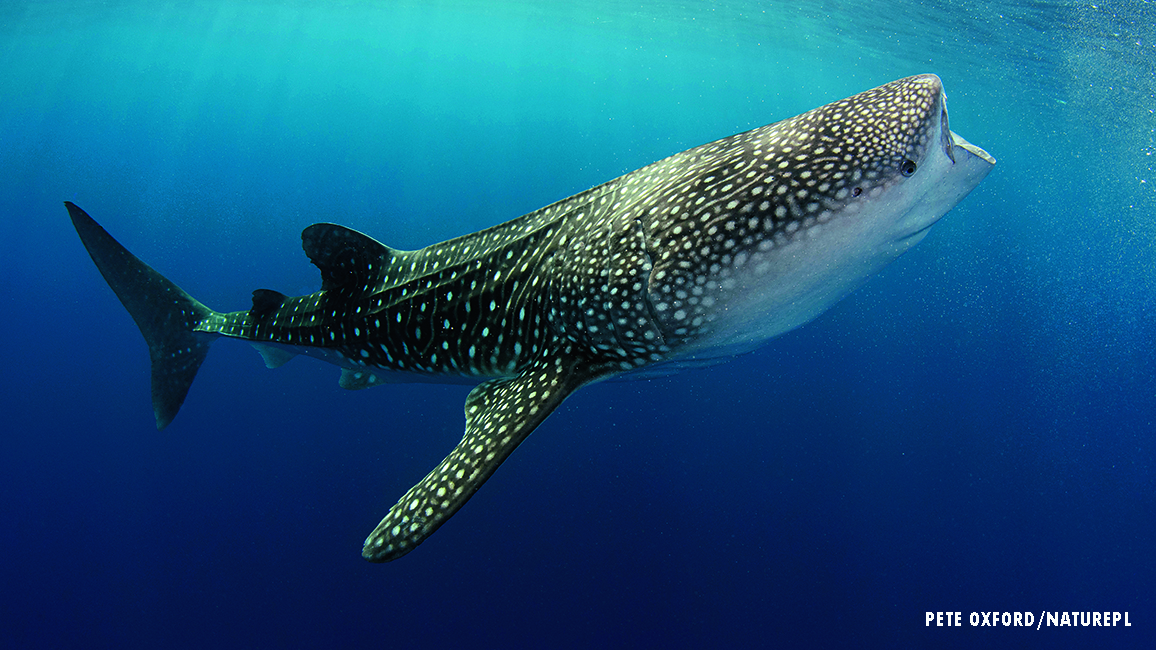
A Whale of a Shark
By Kathy KrankingMeet the whale shark— the biggest fish in the world.
The whale shark is full of surprises. It has “whale” in its name, but it’s not a whale. It has a mouth wide enough for you to fit inside, but a whale shark eats only tiny foods. And even though it’s gigantic, it’s as gentle as a pussycat!
LIKE THE SHARK IT IS
“Whale shark” is a good name for this huge fish. That’s because, even though it’s a shark, it has things in common with whales, too. Most things about it are all shark, though. For example, a whale shark has no bones! Like other sharks, it has a skeleton made of cartilage (KAR-tuh-lij), the same bendy stuff that’s in your nose and ears. The skeletons of whales, on the other hand, are made of bone.

Also, a whale shark breathes underwater using gills. It gets oxygen from the water, so it doesn’t have to come up for air. But a whale has lungs instead of gills. It needs to come to the surface to breathe air through its blowhole.
Here are a couple other differences between a whale shark and a whale: While a whale’s skin is smooth, a whale shark’s skin is covered with small, tooth-like scales called denticles (DEN-tuh-kulz). Also, sharks and whales have different tails. The pointed parts of a whale shark’s tail are at the top and bottom of the tail, while whale tails have the pointed parts on the sides. To swim, whales move their tails up and down. As you might guess, whale sharks move theirs from side to side.

LIKE THE WHALE IT’S NOT
But some things about the whale shark are whale-like. The “whale” part of its name comes from the fact that it’s huge—as long as a school bus! And, just as many kinds of whales do, whale sharks eat zooplankton, tiny animals that drift through the water. To eat them, a shark swims along with its huge mouth open. Or it may stay in one place, sucking in food like a vacuum cleaner!

BIG GULPS
A whale shark has lots of very tiny teeth—about 300 rows of them! But it doesn’t use them for chewing. Whale sharks are “filter feeders,” just as some kinds of whales are. As water and food come into a whale shark’s mouth, the water filters back out through the gills, while the food goes down the shark’s throat.
BIG TRAVELS
Whale sharks live in warm waters all around the globe. Each year, they travel thousands of miles as they search for food. Scientists tracked one whale shark as it traveled more than 12,000 miles across the Pacific Ocean! Whale sharks have a great sense of smell for sniffing out fish eggs, krill, crab larvae (LAR-vee), and other types of plankton.

BIG MYSTERIES
Some things about whale sharks are still unknown. For example, no one knows for sure where whale sharks go to have their babies, or pups. And no one knows where young whale sharks spend their early years. Though nobody has seen a whale shark giving birth, one female was found to have more than 300 pups in her body.
BIG PROBLEMS
Sadly, whale sharks are endangered. There are fewer than half as many now as there were 75 years ago. They face a lot of problems, including getting caught in fishing nets, swallowing tiny bits of broken-down plastic, and being hit by boats. But the good news is that scientists are studying whale sharks to learn all they can about how to keep them safe. In many places, special areas have been created where whale sharks are protected. With luck, these gentle giants will continue making their slow way through the ocean.

















